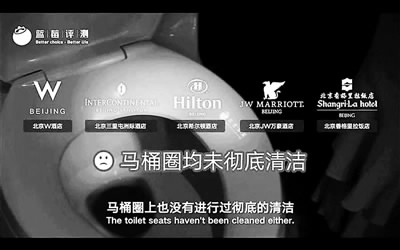
Business
18:17, 06-Sep-2017
Bed sheet scandal puts struggles of China's five-star hotels under the spotlight
Nicholas Moore

A hygiene scandal engulfing luxury hotels in Beijing has rocked the country’s high-end tourism industry. Despite massive potential for growth and huge investment, recent years have seen a slowdown in the Chinese luxury hotel market. Could this latest controversy deal even more damage?
Undercover investigation team Lanmei Test recently revealed how five luxury hotel brands in Beijing – including InterContinental, JW Marriott and Hilton – failed to change bedding in guest rooms, and did not even wipe down toilet seats after guests had checked out.

Image from the undercover investigation by Lanmei Test. /Lanmei Test Photo
Image from the undercover investigation by Lanmei Test. /Lanmei Test Photo
On Wednesday, local media reported that Beijing health authorities would take a look at all five star hotels in the city, following separate internal investigations by some of the hotels featured in Lanmei’s investigation.
The scandal, which follows a 2013 BBC report accusing Kempinski and InterContinental of allowing prostitution rings to operate in some of their Chinese hotels, could seriously harm the reputations of leading global brands in the Chinese luxury hospitality market, which has seen an investment boom in recent years.

Hygiene inspectors investigate a hotel room. /China Daily Photo
Hygiene inspectors investigate a hotel room. /China Daily Photo
A report by IBIS World estimates that hotel revenue in China will be worth 56.2 billion US dollars this year. China Daily reports that Marriott International plans to open 53 more luxury hotels in China, bringing its total presence in the country to 99.
Glut in supply
While many major international brands still see massive potential in China, existing luxury hotels are suffering a glut in supply. Jin Jian of Deloitte China warned China Daily that 50 percent of four- and five-star hotels in the country are looking to be sold because of “poor business performance.”
While the luxury hotel industry continues to grow, it can hardly be described as a boom. A report by website hotelsight found that in the first half of 2017, average occupancy rates in China’s five-star hotels stood at 57.39 percent, representing a year-on-year increase of only 2.79 percentage points.
Revenue per average room (RevPAR) in the first half of the year stood at 287.49 yuan (44 US dollars), falling from 300.40 yuan (46 US dollars) in the last six months of 2016.
While Chinese tourists typically spend more in the last half of the year (because of the October Golden Week vacation), revenues are clearly struggling to increase. Year-on-year, average RevPAR for the first half of 2017 increased by only 0.99 yuan (15 US cents) nationwide.
Struggling to increase
Despite Marriott’s impressive expansion plans, 2016 was also relatively disappointing. Its annual report shows occupancy rates for the Greater China region at 67.5 percent – disappointing when compared to the 75.2 percent occupancy rate seen in the rest of the Asia-Pacific region.
Marriott’s RevPAR in Greater China was 89.17 US dollars, significantly lower than the rest of Asia-Pacific (112.69 US dollars) and the worldwide average (128.37 US dollars).

The Marriott in Jianguomen, Beijing. /AFP Photo
The Marriott in Jianguomen, Beijing. /AFP Photo
One promising indicator is the Greater China region’s average daily rate (ADR), which increased year-on-year by 5.1 percent. This was by far the biggest increase anywhere for Marriott (the worldwide ADR increase was only 0.1 percent).
However, Greater China’s ADR was 132.16 US dollars, much lower than the worldwide ADR of 177.11 US dollars.
The Financial Times reports that InterContinental has also seen its business in China stutter, with its Greater China RevPAR increasing by only 0.3 percent in 2015, compared to 4.4 percent worldwide.
The Chinese luxury market is clearly still lagging behind more established markets, but the rapid expansion of luxury hotel brands in the country represents a strong belief in China’s rapidly expanding middle class as a source of future profits.
Luring China's middle class
McKinsey estimates that by 2022, China will have a middle class population of more than 550 million, while a Ctrip study published in August claimed that the post-90s generation contributed to 50 percent of five-star hotel sales in the weeks before Chinese Valentine’s Day (August 28).
However, these promising trends do not necessarily mean luxury hotels will reap all the rewards.

Chinese tourists are increasingly looking for newer travel experiences. /AFP Photo
Chinese tourists are increasingly looking for newer travel experiences. /AFP Photo
A report by AT Kearney says that while China’s hotel industry still has plenty of room to grow, mid-scale and budget hotels will see the biggest growth in the next decade. By 2022, luxury hotels in China will be worth an impressive 24.8 billion US dollars, but this pales in comparison to a projected 56.8 billion US dollar market for mid-range accommodation.
With the development of online holiday rentals like Airbnb and concepts like ecotourism, adventure travel and boutique hotels, Chinese consumers will have more choice, and this will force luxury hotel chains to rebrand and adapt to the changing demands of the Chinese market.
If luxury brands can’t even maintain basic hygiene standards, Chinese consumers – who are well known for brand loyalty – could be put off from some of the world’s biggest hotel chains for good.

SITEMAP
Copyright © 2018 CGTN. Beijing ICP prepared NO.16065310-3
Copyright © 2018 CGTN. Beijing ICP prepared NO.16065310-3